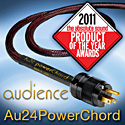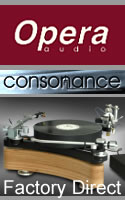|
|
You are reading the older HTML site
Positive Feedback ISSUE 60
sablon audio The Gran Corona AC Power Cord as reviewed by Jeff Day
In Positive Feedback Online Issue 52 I reported on the Sablon Audio Robusto AC power cord ($675 USD), created by the talented cable designer from London, Mark Coles. If you've never heard the difference good power cords can make in a system, you're in for a treat one of these days, for they can truly transform the performance of an audio system. Mark's The Robusto is an extremely good AC power cord, both sonically and musically. As I said in that review, I thought the Robusto was a milestone on AC power cord design, with performance that puts it right at the very top rung in the super power cord category. I thought the Robusto was a musical benchmark when I wrote the review, and in the year since then my admiration for the Robusto has only increased—it's a remarkable achievement by any measure.
In Positive Feedback Online Issue 56 I reported on Mark Coles' Sablon Audio Panatela interconnect ($850 USD per meter) which pretty much blew me away. The Panatela was a revelation for me, and I said, "Every once in a while you listen to a piece of Hi-Fi gear and it completely resets what you think is possible for a genre of gear, and this is what happened with the Panatela interconnect. The difference I heard in musicality and sonic performance in my system was as much of a shock to my expectations as was my first listen to a SET amplifier on that fateful day back in 1996… the Fi 2A3 Stereo was a revelation to me then, and the Panatela interconnect is a revelation to me now—it reset my expectations for what is possible musically and sonically from interconnects."
Now Mark has introduced a second AC power cord to the Sablon Audio lineup, the Gran Corona, and as you might expect with what I've experienced with the Robusto and Panatela, I was really looking forward to giving the Gran Corona a listen in my system. The Gran Corona ($850 USD)
The Gran Corona is now the premier AC power cord in the Sablon Audio line (5-feet for $850 USD). Mark's intention was that the more neutral and transparent Gran Corona provides an alternative voicing to the warm, dark, and rich, Robusto, while still maintaining the musicality of Robusto. Mark told me, "Lessons learned from the development of the Robusto were carried over to the Gran Corona, and although there's a strong superficial resemblance between the two models, the Gran Corona is very different under the skin, and uses a number of advanced techniques in the quest of improved sound quality." During the design process with the Gran Corona, Mark told me he was very focused on achieving a musically involving and natural presentation like the Robusto's, but without compromising on traditional audiophile analytical qualities like transparency and detail recovery so the listener can hear very deeply into the fabric of a recording. This helps give a vivid sense of the three dimensions of the recorded space in the width, height and depth dimensions that make up the soundstage, helps to convey the sense of acoustic 'space' (or soundspace), and helps enhance the feeling of solidity and localization of instruments and musicians on the soundstage (imaging). Mark says the pursuit of audiophile analytical qualities "can often give rise to a thin, fatiguing and un-engaging sound, so I try and start with things the other way around and iteratively improve upon resolution / imaging, etc." So if the Robusto is your favorite girlfriend dressed in jeans and a sweatshirt, the Gran Corona is her dressed in Victoria's Secret lingerie. One presentation is the comfy and snuggly girl you know and love, the other is the same comfy and snuggly girl but she's dressed to reveal a little more skin to pique your imagination and add a bit of eroticism to the mix. Mark told me that driving down the noise floor is one of the largest sources of improvements in the Gran Corona, "since it not only allows more detail through, but also increases dynamic range." Mark went on to say, "The Robusto demonstrated the sonic benefits of using a massive conductor area. Many audiophiles jump to the conclusion that this is due to lowered resistance, and that such a large cord is best suited to power conditioners and amplifiers. This notion overlooks the noise dissipation capabilities of large gauges, however, and some of the most profound improvements achieved by users have actually been on noise sensitive source equipment, especially phono." In the Gran Corona Mark uses a 4 AWG / 21 mm2 copper wire per conductor pole contrasted to the Robusto's 5 AWG / 16 mm2. Mark said that the plug set used on Robusto was the limiting factor on the wire gauge used, and since then he has found a way to use a different, larger gauge cord for the Gran Corona by creating a hybrid plug set by utilizing two different designs. The Gran Corona is terminated with a high purity un-plated copper USA NEMA AC plug on the outlet end, and a rhodium and silver-plated 15 amp IEC connector on the component end, both of which are cryogenically treated, and also with anti-oxidization and contact enhancing treatments. Mark said the geometry he used on Robusto was somewhat unusual, but he chose it because it gave the Robusto such a pleasing musicality. He told me, "I appreciate the Robusto had a 'character' which didn't necessarily appeal to everyone, and I went away to experiment with a number of different configurations to achieve a neutral, but still musical and full bodied, presentation. For many months, I listened to a prototype 'low noise' geometry design, however, it ultimately lacked the musical verve and suppleness of Robusto." Mark said he tracked down the lack of musicality of the prototype to its much higher capacitance. He said, "Although capacitance is not usually a primary consideration for power cords, but based on my experience with the Panatela interconnect design, I revised the Gran Corona design geometry to be more like the Panatela, which resulted in success." Mark says he uses identically sized live and neutral conductors for the best performance in both normal domestic and balanced power supplies. Mark also improved the grounding of the Gran Corona by using a much larger earth lead, which he says reduces impedance, resulting in a cleaner presentation. The Gran Corona includes noise-reducing crystals in its design much like the superb Acoustic Revive RAS-14 AC conditioner ($1295) that I reviewed back in Issue 55. Mark told me that he found that the benefits crystals can offer in scrubbing noise off the power supply were considerable. Mark evaluated a variety of crystal types, and uses different blends of crystals in the IEC and AC plug bodies, respectively, to work synergistically with the types of metals used in each. Mark said, "These are surprisingly effective at mopping up any residual noise, and are like a mini power conditioner incorporated within the cord." Mark also uses UNIKO Anti-Vibration Magic paint applied in key locations of the Gran Corona to dampen parts prone to resonance, which reduces noise. Mark said, "Whilst I can't profess to fully understand how or why this should work, it is effective, and improves image stability and focus without adding any glare." Mark pointed out to me that he uses cryogenic treatment extensively for the Gran Corona to lower the noise floor further and improve conductivity. He said, "The benefits of this approach have been extensively documented over the years and are now widely accepted. Clearly something has changed, as the cords now need an extra 50% more time on the Audiodharma cable cooker to fully burn in." After the assembly process each Gran Corona it is tested for shorts and continuity, and then Mark pre-conditions it before delivery using afore mentioned Audiodharma Anniversary cable cooker. So there you have it. Each Gran Corona is hand assembled in a labor- and tweak-intensive process. Mark incorporates every refinement into the Gran Corona possible, and along with very careful and astute listening, Mark's attention to detail and refinement yields products that win continued praise from the audio community. As a side note that will interest owners of Shindo electronics, Mark makes dedicated versions of the Gran Corona that are designed to be compatible with Shindo designs. As some of you are aware of, Shindo amplifiers are a little 'different' from the norm in their design, and Shindo advises that their electronics only work optimally with the power cords provided with them. However, Shindo enthusiasts too are interested in high-performance power cords for their amplifiers, and predictably, as word got around about Mark's skills with all things wire, some Shindo owners asked him if there was a way to optimize a power cord for their Shindo amplifiers. Mark told me that with Shindo amplifiers "part of the equation is that they are run ungrounded, presumably to maximize signal to noise performance. The other Shindo design aspect appears to be that they use a bit of a different power supply topology that also needs to be taken into account." As Mark studied what the Shindo requirements were for a power cord, he developed a version of the Gran Corona that specifically addressed those requirements. Word is that Mark hit it out of the ballpark, and Shindo owners love the Shindo-specific version of the Gran Corona. So if you are a Shindo owner you now can get an ultra-performance power cord for your amplifier. Listening Impressions
For this review I used my 'SET-horn' system to gather listening impressions: Tannoy Westminster Royal Special Edition loudspeakers, Sophia Electric 300B mono amplifiers, Auditorium 23 speaker cables, a TEAD interconnect from the Sophia amps to a Leben RS-100 preamplifier, Panatela interconnects from the RS-100 to the Leben RS-30EQ phono stage, an Acoustic Revive interconnect to an Auditorium 23 step-up transformer, and another Panatela interconnect from the Auditorium 23 step-up to my VPI Classic turntable, with an EMT TSD-15 moving coil phono cartridge mounted on the VPI JMW 10.5i tonearm. The power cords on all my electronics were Sablon Audio's 'The Robusto'.
My goal for gathering listening impressions was to try to characterize the sonic and musical performance spectrum of the Sablon Audio Robusto, Sablon Audio Gran Corona, and Acoustic Revive Power Reference AC cables power cords (Issue 39) in three different locations in my system: 1) on the Sophia Electric 91-01 300B mono power amplifiers, 2) on the Leben RS-100 preamplifier, and 3) on the Leben RS-30EQ phono equalizer. I thought an across-the-system approach would give you the best idea possible about how these three super AC power cords sound and work in the different equipment contexts that you can then extrapolate to your own systems. Performance on the Sophia Electric 91-01 300B Mono Power Amplifiers
I did considerable focused listening to the three AC power cords on the Sophia Electric 300B mono amplifiers to get an understanding of what they were doing from an Eastern-style timbral listening perspective (listening to way they handle the textures, colors, and tones and overtones of the musicians and instruments), a Western-style musical content listening perspective (listening to the way they handle the melody, harmony, rhythm, tempo, etc., elements of music), as well as listening for their performance on audiophile-style recording artifacts (listening for imaging, soundstaging, soundspace, detail recovery, etc.), and most importantly, evaluating how all those listening elements come together to create a musically evocative and emotionally charged listening experience, which is of course the ultimate raison d'être for any piece of Hi-Fi gear. I felt like listening to the Friday Music LP version of the America self-titled debut folk rock album, so I got it out and cued up Dewey Bunnell's A Horse With No Name, and sat down for a little listening to this gem from 1972. For those who are not familiar with this song, it was recorded in E minor with both six and twelve string acoustic guitars, a bass guitar, and bongo drums. With the Robusto I immediately connected with the song and was pulled into the music, and started singing along with the lyrics, enjoying the Robusto's ability to convincingly convey America's signature sound, by giving an honest portrayal of their timbral realism at the band level. At the individual instrument level, the acoustic guitars, bass guitar, and bongos displayed the timbral textures, colors, and tones and overtones that I want to hear in the music, albeit in a slightly softened and romanticized fashion that I personally find very endearing.
The way the Robusto presented the melody line (the tune you 'whistle while you work') was absolutely mesmerizing, and was highlighted in the music, as it should be. This presentation of an engaging melody line has a lot to do with the way the Robusto handles the dynamics, which was as near a perfect match for my Westminster SE loudspeakers as it could be. The rhythm accompaniment (that steady beat that determines the tempo) carried the music along quickly with an upbeat tempo, that when combined with the driving bass line, gave a tangible sense of exhilaration and visceral excitement that really kept my head bobbing and my foot tapping to the music, and made for an interesting contrast to the bleak images evoked by the lyrics and E minor key. The harmony lines (the treble and bass accompaniments to the melody line) really fleshed everything out, giving a depth and interesting counterpoint to the music, and the Robusto really brought this aspect of music making out. Musically speaking the Robusto was impressive, and it really nails the fabric of the musical content of a recording in its presentation of melody, harmony, and rhythm. On audiophile-style recording artifacts the Robusto's performance is quite good, with solid imaging, a soundstage presentation with good depth and layering, good detail recovery, and a good sense of recorded space. The Acoustic Revive Power Reference AC cord on A Horse With No Name has more clarity and greater detail recovery than the Robusto—almost shockingly so—making it easier to identify all the different musical contributions from the various instruments. It's almost as if the microphones had been moved close to the musicians to capture extra detail. The Acoustic Revive's timbral presentation of the textures, colors, and tones and overtones of the acoustic guitars, bass guitar, and bongos were displayed in a more vivid, and more live music-like fashion than with the Robusto, whose presentation was more romanticized in comparison. Musically, the Acoustic Revive Power References displayed the melody, harmony, and rhythm elements of the music more distinctly, making each contribution to melody, harmony, and rhythm more obvious, and easier to tease out of the recorded mix. So while the Acoustic Revive superbly renders timbral attributes, its more analytical presentation of the musical elements of melody, rhythm, and harmony in the recording don't always work in its favor, making it a little harder to melt into an emotional connection with the music than with the Robusto. On audiophile-style recording artifacts the Acoustic Revive Power Reference performs at a level higher than the Robusto. The Acoustic Revive Power Reference has immense clarity and detail recovery, solid pinpoint imaging, a wider soundstage presentation than the Robusto, and it filled the room with lots of depth, layers, and images from the recording in a rather dramatic fashion. The sense of recorded space with the Acoustic Revive is astonishing, filling the room in an immersive fashion. Overall the Acoustic Revive is leaner and brighter sounding than the dark and rich Robusto. With the Gran Coronas hooked up to my Sophia 300B monos I was struck by how much of the richness and musicality of the Robusto found its way into the Gran Coronas, yet compared to the Robusto, how dramatic the increase in sonic prowess was at the same time. On A Horse With No Name the soundstage was exceptionally wide, considerably wider than even the Acoustic Revive, which until now I have thought of as the benchmark for soundstage width. The Gran Corona can't quite match the clarity and detail recovery of the Acoustic Revive, and as such its soundstage doesn't seem to go quite as deep as the Acoustic Revive's does, but it is still exceptional by any measure. The Gran Corona's imaging is spectacular, with intensely solid and colorful images emerging out of an inky black background. The Gran Corona images have more body to them than do the Acoustic Revive's, but perhaps less pinpoint accuracy and sharply defined image outlines. The Gran Corona also fills the room with lots of acoustic space, but not in the same sort of fashion as the immersive Acoustic Revive does, which has a nearly effervescent quality to its presentation of a recording acoustic that still remains a benchmark. The Gran Corona nearly matches the Acoustic Revive's presentation of timbral textures, and it exceeds the Acoustic Revive's performance in the way it presents tonal color, being more deeply saturated in hue, with a positively gorgeous presentation of tones and overtones, and with a captivatingly beautiful way that the notes decay into the blackness of the background. Musically, the Gran Coronas displayed the melody, harmony, and rhythm elements of music as distinctly as did the Acoustic Revive, allowing their contribution to be easily teased out of the mix, but like the Robusto the Gran Corona made it easy to melt into an emotional connection with the music. This is what makes the Gran Corona so special: it is able to go toe-to-toe with the Acoustic Revive in every timbral and sonic category, yet the Gran Corona delivers a devastating knockout punch musically—the Acoustic Revive simply cannot match the Gran Corona for sheer musicality. The amplifier verdict: Each of these three super AC power cords were really a lot of fun to listen to on my Sophia Electric 300B mono amplifiers, and focused listening sessions utilizing a wide variety of music really helped me to get an understanding of what they were doing from timbral, musical, and audiophile style listening perspectives. The Acoustic Revive Power Reference was the unquestionable champion in the way it presented timbral textures among the three cords, followed by the Gran Corona, and then the Robusto. When it came to tone color and overtone presentation the Gran Corona was the undisputed champion, followed by the Robusto, and then the Acoustic Revive. When it came to portraying the musical elements of melody, harmony, and rhythm in a recording, the Gran Corona and Robusto were almost dead even, with the Acoustic Revive bringing up the rear. When considering these three super cords' performance on audiophile-style recording artifacts like imaging, soundstaging, detail recovery, etc., the Acoustic Revive was the clear winner, closely followed by the Gran Corona, with the Robusto trailing a bit behind. So you're probably wondering how all those aspects of performance come together to create a musically evocative and emotionally charged listening experience, the raison d'être for these power cords? The AC power cord I decided I'd most like to have plugged into my Sophia Electric 91-01 300B mono amps for the long haul is the Sablon Audio Gran Corona. After listening to a broad variety of music, it was the Gran Corona that got my nod for being the most consistently enjoyable, most musically balanced, and most emotionally engaging power cord of the three, closely followed by the Robusto, and then the Acoustic Revive. Performance on the Leben RS-30EQ Phono Equalizer
Now, let's take a listen to these three super AC cords on the Leben RS-30EQ phono equalizer, and see what happens. I chose one of my favorite recent reissues, the Analogue Productions Getz / Gilberto 45-RPM Verve reissue mastered by George Marino and pressed at Quality Record Pressings for a little comparative listening session. This jazz bossa nova album was originally released on Verve in 1964 and features Stan Getz (tenor saxophone), Astrud Gilberto (vocals), João Gilberto (guitar, vocals), Antonio Carlos Jobim (piano), Sebastião Neto (bass), and Milton Banana (drums). The Acoustic Revive Power Reference was up first on the jewel-like little Leben RS-30EQ phono equalizer, and it presented The Girl From Ipanema in a beguilingly musical way. Overall the presentation was rich, effortless, and eminently natural sounding. João Gilberto's vocal came through as rich and smooth, with Astrud Gilberto's voice breathy with lots of space around it. As I was listening to the timbre of the instruments, I was thinking that if that wasn't exactly the way they sounded in life, well, then maybe they ought to have. Beautiful tone color, rich textures, and stunningly musicality made the timbral presence come to life with the Acoustic Revive providing the AC. The melody line was absolutely mesmerizing, and highlighted, just as it should be. João's rhythm accompaniment was perfection, as was Milton's drumming. Sebastião's bass line kept things moving along nicely, Getz's saxophone had stunningly beautiful tone, and Jobim's playing on the piano… well, what can I say, the whole effect was one of absolute musical nirvana. I don't think anyone could find fault with the way the Acoustic Revive Power Reference made music come alive on the Leben RS-30EQ, it was just flat out impressive.
With the Acoustic Revive Power Reference replaced by the Robusto on the Leben RS-30EQ, the differences were immediately obvious, with a bigger, darker, more colorful – albeit slightly courser—sound. Dynamic contrasts were bigger and more noticeable with the Robusto, and interestingly, the Robusto sounded louder than the Power Reference at the same volume setting, almost like the volume had been turned up a click on the Leben RS-100 (which it hadn't). The Robusto also emphasized the first attack on an instrument more, where the Acoustic Revive had less sense of the initial attack, combined with a longer decay to the notes. The audiophile-style sonics of imaging, soundspace, and soundstaging were more distinct with the Robusto on the RS-30EQ, which was a complete reversal of what happened with the Sophia Electric 91-01 300B monos where the Acoustic Revive ruled on recording artifact front. The way the Robusto portrayed the musical elements of melody, harmony, and rhythm in the recording did not fare as well as with the Power Reference, as they didn't integrate quite as well into a cohesive musical whole. With the Gran Corona providing the AC on the Leben RS-30EQ, it had the same "I'm louder" effect over the Acoustic Revive that the Robusto did. I asked Mark if he knew what was responsible for the Sablon Audio's power cords "loudness" effect and he thought it might be due to the lower capacitance of their unshielded designs. Whatever the reason, it was immediately noticeable. The Gran Corona outperformed the Acoustic Revive Power Reference in all the audiophile sonic artifact parameters of imaging, soundstaging, soundspace, detail recovery, and the like, on the Leben RS-30EQ, which was the exact opposite of what I observed between these two AC cords when used on the Sophia Electric 91-01 300B mono amplifiers. On the Leben RS-30EQ the Gran Corona was overall rather dark, but even more detailed than the brighter lit Acoustic Revive, which was an interesting counterpoint. With the Gran Corona, the tone color was deeper hued, more intense and lively, and the presentation of overtones was more vivid. On musical elements like melody, harmony, and rhythm in a recording, the Gran Corona made the different component pieces more obvious. The Leben RS-30EQ phono preamplifier verdict: When it came to tone color and overtone presentation the Gran Corona was the undisputed champion, followed by the Robusto, and then the Acoustic Revive. The Gran Corona had a more deeply infused tone color, almost vivid in a Technicolor film sense, which gave a grandness of tone color that was rather addicting. The Gran Corona was also the unquestionable champion in the way it presented timbral textures among the three cords, followed by the Acoustic Revive Power Reference, and then the Robusto. With the Gran Corona you get a 'first row' presentation of timbral textures, whereas with the Acoustic Revive it's more like mid-hall. The Robusto falls somewhere between the two, but it is not as successful in portraying the subtleties of textures, as it's a little courser in its presentation of texture, but not pejoratively so. The Acoustic Revive Power Reference had the most balanced portrayal of the musical elements of melody, harmony, and rhythm in a recording, with the Gran Corona next, and then the Robusto. By comparison to the Acoustic Revive, the Gran Corona made me more aware of the individual musical components, but at somewhat of a cost to overall cohesiveness of the music. Performance on audiophile-style recording artifacts like imaging, soundstaging, detail recovery, etc., went clearly to the Gran Corona, followed by the Acoustic Revive, and then the Robusto. Given what I wrote above, you'd expect that the Gran Corona would be the overall best performer on the RS-30EQ, but it turned out the Acoustic Revive Power Reference took home the top honors, followed closely by the Gran Corona, and a little further back was the Robusto. The Acoustic Revive simply puts all the timbral, musical, and sonic traits together in a way that best serves the RS-30EQ, and gives the most convincingly musical result. Performance on the Leben RS-100 Line Preamplifier
Ok, now let's check out these three AC power cords on the Leben RS-100 line preamplifier, and see what happens. For this listening comparison, first up was Analogue Productions' new 45-RPM LP reissue of Oliver Nelson's The Blues and the Abstract Truth, featuring Oliver Nelson alto and tenor saxophone, Eric Dolphy on flute and alto saxophone, George Barrow on baritone saxophone, Freddie Hubbard on trumpet, Bill Evans on piano, Paul Chambers on bass, and Roy Haynes on drums.
First up was the ever-musical Robusto, and just as you would expect with the Robusto providing the AC, my focus was drawn immediately to the beauty of the music. Tone color and overtone presentation were what I've come to expect from the Robusto—very good – as were the presentation of timbral textures. The Robusto's portrayal of the musical elements of melody, harmony, and rhythm never failed to mesmerize me, integrating into a cohesive whole that I always found satisfying and musically complete. Sonically the Robusto is dark and rich sounding on the Leben RS-100, with good (but somewhat diffuse) imaging, wide soundstaging, with good (but not great) soundstage depth and detail recovery. The strength of the Robusto on the Leben RS-100 line stage was the overall way the timbral, musical, and sonic traits blend together to give an incredibly satisfying—almost hypnotic—music listening experience. Next up was the Gran Corona on the Leben RS-100 line stage. What I noticed first with the Gran Corona on the Leben RS-100 was that while it retained the musicality of the Robusto, it had much greater transparency and detail recovery, a greater sense of space, more pronounced macro-dynamics, and much deeper soundstage depth. The Gran Corona also had deeper hued tone color, and the overtone presentation (and decay of overtones) was much more tangible and distinct, making timbral textures even more life-like than the Robusto. Like the Robusto, the portrayal of the musical elements of melody, harmony, and rhythm were extremely good, and will be a delight and revelation to music lovers who are not used to hearing this kind of musical magic from AC power cords. The Gran Corona puts a 360-degree cushion of air around each of the instruments in the soundstage, which you don't hear with the Robusto, which really adds to a sense of space and recorded ambience. The soundstage width of the Gran Corona is rather remarkable, and I said earlier, it sets a new reference in that performance attribute. Taking all of the timbral, musical, and sonic attributes of the Gran Corona together, it retains the remarkable musicality of the Robusto (actually betters it), and provides a huge leap forward in sonic prowess across the board. Now let's take a listen to the Acoustic Revive Power Reference on the Leben RS-100. The first thing that I notice with the Power Reference is that the bass line not as taut and resolved, and not as tuneful as with the Gran Corona. The Power Reference is also brighter, giving more emphasis on cymbals, and a more expansive sound to the horns, compared to the Gran Corona. Tone color is a little less saturated with the Power Reference compared to the Gran Corona, but the Power Reference bests the Gran Corona in the way overtones decay. The Power Reference is also less dynamic than the Gran Corona. Even though the power reference is brighter than the Gran Corona, it resolves less detail and is somewhat less transparent looking into the depth dimension of the soundstage, but not by much. This slight diminution of detail recovery and transparency of the Power Reference compared to the Gran Corona resulted in less of a sense of space around instruments in the soundstage, but conversely does portray timbral textures a little more true to life, which makes the music feel a little more cohesive. The Gran Corona bested the Power Reference musically, with the musical elements of melody, harmony, and rhythm feeling a little less integrated and musically natural with the Power Reference than with the Gran Corona. Taking all the timbral, musical, and sonic traits together, as a complete package the Power Reference comes up a little short compared to the Robusto, and particularly the Gran Corona, which are just more compelling to listen to music with when plugged into the Leben RS-100 line preamplifier. Before closing I was curious to hear what would happen if I used the Acoustic Revive Power Reference AC power cord ($750 USD for a 2 meter power cable) with the Acoustic Revive RAS-14 AC conditioner ($1295 USD, Issue 55), which as I mentioned earlier also uses noise-reducing crystals in its design, making the combination more comparable to the technology used in the Gran Corona. Adding the RAS-14 to the Power Reference made it sound much more like the Gran Corona, and even now besting it in some attributes. With the addition of the RAS-14 to Power Reference the soundstage opened up in every dimension: width, depth, height, and in fact now bested the Gran Corona in soundstage width. The sense of space that resulted from the RAS-14 infused my room to a greater extent than with the Gran Corona. The sense of recovered detail also went up with the RAS-14 on the Power Reference, and was directly competitive with the Gran Corona in detail recovery. The addition of the RAS-14 to the Power Reference increases soundstage performance, improves detail recovery, improves sense of space, and improves musically important things like timbre, melody, harmony, and rhythm noticeably. The combination of the Acoustic Revive AC power cord plus the RAS-14 AC conditioner outperforms the Gran Corona sonically, but the Gran Corona still maintains a performance edge from a musicality perspective. As a complete package, I preferred the overall timbral, musical, and sonic presentation of the Gran Corona on the Leben RS-100, it just made music listening more fun and musically satisfying. Summary and Conclusions
It is clear that the Sablon Audio Gran Corona AC power cord designed by Mark Coles is a tour de force in power cord design, and I preferred the Gran Corona on my Sophia Electric 91-01 300B mono amplifiers and the Leben RS-100 line amplifier by quite a margin to both the Sablon Audio Robusto and Acoustic Revive Power Reference, and in that order. The Gran Corona had a combination of sonic prowess and overall musicality that really impressed me, creating a musically evocative and emotionally charged listening experience that once heard is quite addictive and memorable. Overall the Gran Corona is still a touch to the warm and dark side of neutral, yet it provides incredible transparency and detail recovery, deeply infused tonal colors, accurate timbral signatures, and state-of-art performance on attributes important to audiophiles like imaging, soundstaging, dynamics, and soundspace reproduction. I found comparing these three super AC power cords to be really interesting, and the magnitude of performance increase can be quite startling if your frame of reference has been an OEM AC power cord. I didn't include an OEM AC power cord as part of the review, as any of these three super power cords perform at levels so vastly above what a generic power cord is capable of that it would have been a ridiculous comparison. It's safe to say that you'll be astounded by how much any of these three super AC power cords can improve the performance of your equipment over a generic 'from the manufacturer' power cord. Given the superb performance that resulted when using the Gran Corona on the Sophia 91-01 and the Leben RS-100, I was somewhat surprised by the synergy between the Acoustic Revive Power Reference and the Leben RS-30EQ phono equalizer, which I found to be quite an enticing combination, and it wasn't the expected result. I do think that the Gran Corona is the best AC power cord of the three in absolute performance terms, but it was also clear to me that there was still a wildcard element of AC power cord 'flavor matching' involved with some components—like the RS-30EQ—to get the best overall performance. The bottom line is this: prepare to be impressed, as the Sablon Audio Gran Corona is the real deal. The Gran Corona incorporates every technological refinement extant into its tour de force design. In a hand assembled, labor and tweak intensive process, Mark, through very careful and astute listening, has created in the Gran Corona a superbly musical and sonically spectacular AC power cord. The Gran Corona unfailingly delivered a musically evocative and emotionally charged listening experience that I enjoyed coming back to time and time again. A smokin' hot Gran Corona—way to go Mark! Jeff Day
Sablon Audio
|






















